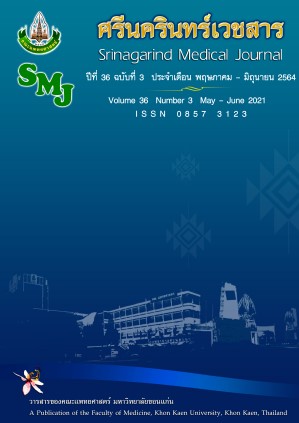ผลการศึกษาการให้ยาต้านจุลชีพชนิดฉีดแบบต่อเนื่องในผู้ป่วยนอก โรงพยาบลสวรรค์ประชารักษ์
Abstract
หลักการและวัตถุประสงค์ : จากแนวโน้มการสั่งใช้ยาต้านจุลชีพชนิดฉีดในผู้ป่วยนอกที่มีเพิ่มมากขึ้น อีกทั้งยังกลายเป็นมาตรฐานหนึ่งของการรักษาโรคติดเชื้อในหลายประเทศทั่วโลก การศึกษาวิจัยนี้จึงมีวัตถุประสงค์เพื่อ ประเมินผลการรักษาด้วยยาต้านจุลชีพชนิดฉีดแบบผู้ป่วยนอกสำหรับการรักษาโรคติดเชื้อที่ได้รับยาจากโรงพยาบาลสวรรค์ประชารักษ์
วิธีการศึกษา : เป็นการศึกษาเชิงพรรณนา ในผู้ป่วยนอก ที่ได้รับยาต้านจุลชีพชนิดฉีด จำนวน 529 ราย ระหว่างวันที่ 1 ตุลาคม 2562 ถึง 30 กันยายน 2563
ผลการศึกษา : มีการสั่งใช้ยาต้านจุลชีพชนิดฉีดแบบผู้ป่วยนอก จำนวน 616 คอร์ส ในผู้ป่วย 529 ราย แผนกที่มีจำนวนครั้งการสั่งใช้ยามากที่สุดคือ อายุรกรรม 289 คอร์ส (ร้อยละ 46.90) โดยยาที่มีการสั่งใช้มากที่สุดคือ Ceftriaxone 426 คอร์ส (ร้อยละ 67.73) การติดเชื้อที่พบส่วนใหญ่คือ การติดเชื้อในระบบทางเดินปัสสาวะ 228 คอร์ส (ร้อยละ 37.01) ผู้ป่วย 318 ราย (ร้อยละ 51.62) เลือกมาใช้บริการฉีดยาแบบผู้ป่วยนอกที่โรงพยาบาลสวรรค์ประชารักษ์ ปัญหาการสั่งใช้ยาที่พบมากที่สุดคือ ไม่ระบุชนิดของสารละลายและอัตราการให้ยาแบบหยดเข้าหลอดเลือดดำ ร้อยละ 98.92 ผลจากการรักษาโรคติดเชื้อโดยการให้ยาต้านจุลชีพชนิดฉีดแบบผู้ป่วยนอกพบว่า ผู้ป่วยมีอาการดีขึ้นร้อยละ 90.90 ผู้ป่วยร้อยละ 4.06 ต้องกลับเข้ารับการรักษาในโรงพยาบาล เนื่องจากอาการติดเชื้อเดิม พบการเกิดอาการไม่พึงประสงค์จากยา และผู้ป่วยมาฉีดยาไม่ครบตามแผนการรักษา 3 ราย และ 18 ราย ตามลำดับ
สรุป : ผลของการรักษาโรคติดเชื้อแบบ OPAT ส่งผลทำให้ผู้ป่วยมีอาการที่ดีขึ้นจากการติดเชื้อสูงถึงร้อยละ 90.90 อีกทั้งยังสามารถลดวันนอนโรงพยาบาลของผู้ป่วยและค่าใช้จ่าย ลงได้ 3,736 วันนอน มากกว่า 2.5 ล้านบาท ในปีงบประมาณ 2563 การวางแนวทางการส่งต่อผู้ป่วยโดยเภสัชกร รวมถึงข้อมูลและวิธีการบริหารยา พบการเกิดอาการไม่พึงประสงค์จากการบริหารยาเพียง 3 ราย และผู้ป่วยมาฉีดยาไม่ครบตามแผนการรักษา ร้อยละ 2.92
คำสำคัญ: ยาต้านจุลชีพ; ผู้ป่วยนอก; การให้ยาต้านจุลชีพแบบผู้ป่วยนอก; วันนอนโรงพยาบาล
Background and Objective: Increasing the use of outpatient intravenous antibiotic therapy and Outpatient parenteral antimicrobial therapy (OPAT) program have been developed standardization in many country. Objective of this research is to assess the effects of continuous antibiotic injection in the treatment of infectious diseases in outpatients who receiving medicine at Sawanpracharak Hospital
Methods: The descriptive study was performed in 529 outpatients receiving antibiotic injection between 1 October 2019 to 30 September 2020.
Results: According to the study, 616 episodes OPAT for 529 patients were prescribed. The department which was the highest amount of prescribing was internal medicine (289 episodes, 46.90 %). The most commonly prescribed drug was ceftriaxone 426 episodes (67.73%). The most infectious disease was urinary tract infections 228 episodes (37.01%). There were 318 patients ( 51.62%) using an outpatient injection service at Sawanpracharak Hospital. The most drug related problem prescription error was that the type of solution and the dose rate of administration was not specified 98.92%. Treatment outcomes were clinical improvement by 90.90% and 4.06% of patients had to admit in hospital for treatment infection. There were adverse drug event 3 cases and none-compliance 18 cases.
Conclusion: Outcomes of The continuous antibiotic injection in outpatients. there was clinical improvement 90.90 % can reduce length of stay and also reduce the cost of hospital stay by more than 2.5 million bahts per year. Orientation for referring to patients by pharmacists. There were adverse drug event 3 cases and none-compliance 2.92%.
Key word: antibiotic; out patient; Outpatient parenteral antimicrobial therapy (OPAT); length of stay


